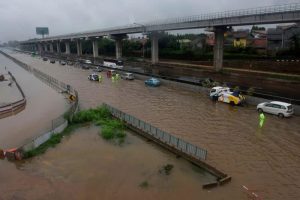In year 2020, some of the worst rainfalls hit Jakarta. This resulted in a big increase of floods and other types of natural disasters. The lives of many were lost due to this. This city is one of the fastest sinking countries in the world. It’s scientifically proven that it’s sinking rate is 25cm per year in certain areas, and the city is currently sitting below sea level. Scientists expect the city to be fully submerged into the sea waters sometime around 2050.
Impact on citizens:
Jakarta is the home of over 30 million people, but global warming occasions caused approximately 170,000 residents to flee and seek refuge. The increase of floods and heavy rain has negatively affected residents from certain areas to abandon homes and business. This also leads to a higher risk of Jakarta’s citizens being contaminated by water-borne diseases.
Why is it sinking?
1. Groundwater pumping
60% of the city relies on groundwater, filling up ⅔ of the city’s water consumption. Annually, there is approximately 600 million cubic metres of water being pumped from the grounds. This loosens the strength in the ground below, which causes water to flood onto the above grounds.
2. Climate change
Rising sea levels across the world puts Jakarta at a higher risk of sinking. Many walls have been built and installed around parts of the city. But due to the fact that time passes fast, the walls are already facing leaks.
Previous Natural Disasters:
In 2007, floods and heavy rainfall damaged the city severely. Approximately over 300,000 people had to be evacuated and 80 residents lost their lives. Sometime in 2013, another heavy flood hit the city. Many poor provinces were highly damaged. As a result, more than 1000 residents had to be evacuated and 45 lost their lives on the way.
Ways to help:
The current issue of Jakarta sinking has existed for years. Collapsing land, an increase in sea level and poor development of infrastructure has caused the city to slowly disappear from the above lands. Jan Jaap Brinkman, a hydrologist, states that helping Jakarta to escape the risk of sinking into the oceans requires a long term solution. That is to reduce the amount of groundwater extraction. Transfer of water can be from manufactured reservoirs and river waters. As a result, this would lead to a big decrease in the annual sinking rate for Jakarta. Tokyo, Japan, has decided to replace their groundwater extraction with a much safer technique. This led to a halt in the land subsidence. Tokyo has now stepped away from the risky situation of sinking to the bottom of the ocean.
There should be more done to address the current crisis of Jakarta. The city is in great danger and is on the edge of being underwater. If the current situation doesn’t change fast enough, the city may be the real lost Atlantis in 2050.
Short video about the change in Indonesia’s capital city due to the sinking crisis:
Moving its capital (sinking) city (Indonesia) – BBC News – April 2019 – YouTube
Resources/References:
Sinking cities around the world – CNN
Why Is Jakarta Sinking? – The Organization for World Peace (theowp.org)

